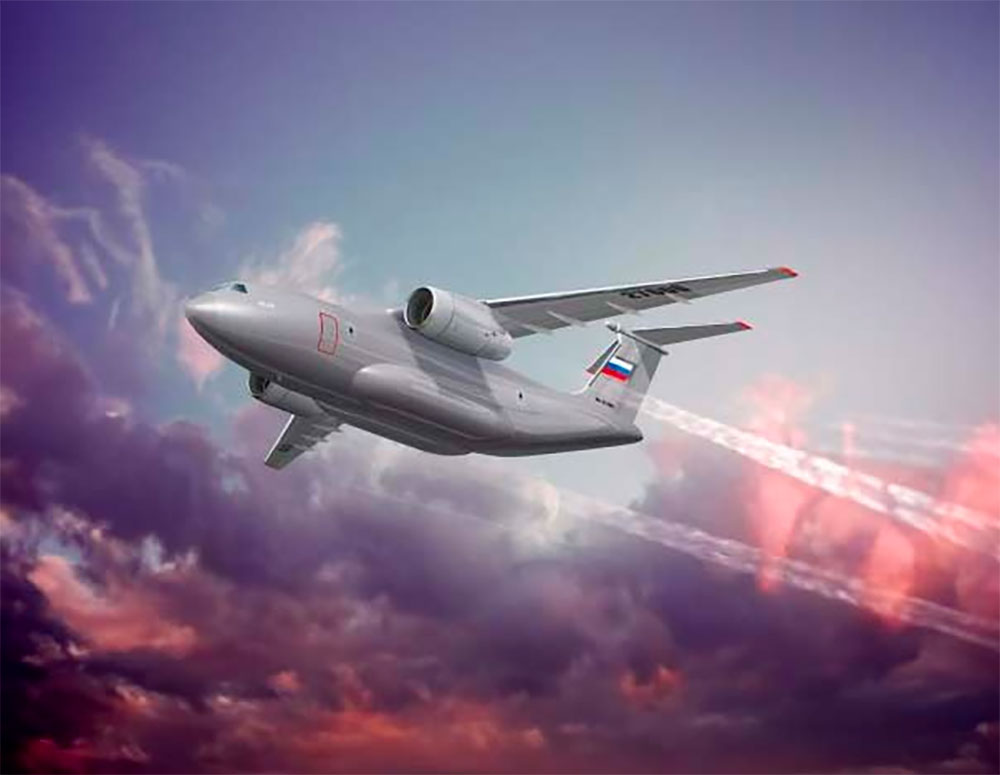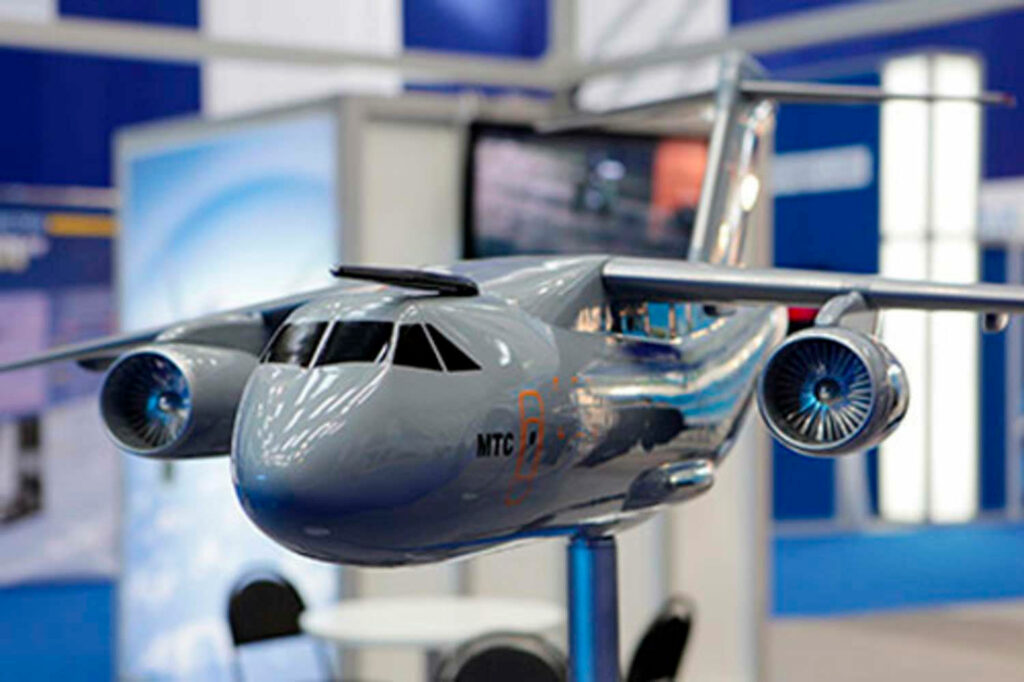The Ilyushin IL-276 SVTS is a medium-lift military transport aircraft under development, designed to carry up to 20 tons of cargo over 2,000 km.
The Ilyushin IL-276 SVTS is a twin-engine, medium-lift military transport aircraft currently under development by the United Aircraft Corporation (UAC) of Russia. Designed to replace aging fleets such as the Antonov An-12, the IL-276 aims to fulfill both military and commercial transport roles. It features a high-wing monoplane design with a T-shaped tail and is powered by two Aviadvigatel PD-14M turbofan engines, each providing approximately 34,392 pounds (15,600 kg) of thrust. The aircraft is capable of transporting up to 20,000 kilograms (44,000 pounds) of cargo over a range of 2,000 kilometers (1,243 miles) and has a maximum takeoff weight of 72,000 kilograms (158,733 pounds). Its cruising speed is projected at 800 km/h (497 mph), with a maximum speed of 870 km/h (541 mph). The IL-276 is expected to enter service with the Russian Aerospace Forces, with initial flight tests planned for 2023 and deliveries anticipated by 2026.
History of Development
The development of the Ilyushin IL-276 SVTS traces back to the late 20th century, during a period marked by significant geopolitical shifts and evolving military requirements. In the 1980s, the Soviet Union recognized the necessity to replace its aging fleet of Antonov An-12 aircraft, which had been the backbone of medium-range military transport operations since the 1950s. The An-12s, while robust, were becoming obsolete in the face of modern logistical demands and technological advancements.
In the early 2000s, Russia sought international collaboration to rejuvenate its military transport capabilities. This led to a partnership with India’s Hindustan Aeronautics Limited (HAL) in 2009, aiming to jointly develop a Multi-role Transport Aircraft (MTA) that would serve both nations’ air forces. The collaboration intended to produce an aircraft capable of carrying up to 20 tons of cargo, with both countries sharing development costs and production responsibilities. However, by January 2016, differing requirements and priorities led to India’s withdrawal from the project, prompting Russia to continue the development independently.
The project, initially referred to as the MTA or Il-214, was officially renamed the IL-276 in June 2017. The Russian Ministry of Defense identified a need for at least 55 units to replace the An-12 and enhance the capabilities of the Russian Aerospace Forces. The IL-276 was designed to address specific operational gaps, offering improved payload capacity, range, and versatility compared to its predecessors. The aircraft’s development has been managed by the United Aircraft Corporation (UAC), with Ilyushin serving as the principal design bureau.
The IL-276 is slated to make its maiden flight between the end of 2023 and mid-2024, with serial production expected to commence shortly thereafter. The aircraft is anticipated to enter service by 2026, providing a modern solution to medium-lift transport needs and ensuring the continued operational readiness of Russia’s air mobility forces.

Design
The Ilyushin IL-276 SVTS features a high-wing monoplane configuration with a T-shaped tail empennage, optimizing it for both aerodynamics and ground operations. This design facilitates excellent ground clearance, allowing operations from unprepared airstrips and enhancing versatility in various terrains.
The aircraft’s fuselage measures approximately 37.7 meters (123 feet 8 inches) in length, with a wingspan of 35.5 meters (116 feet 6 inches) and a height of 12.95 meters (42 feet 6 inches). The cargo compartment is designed to accommodate a wide range of payloads, measuring 13.9 meters in length, 3.5 meters in width, and 3.4 meters in height. This spacious interior allows for the transport of up to 20,000 kilograms (44,000 pounds) of cargo, including military equipment, vehicles, and personnel.
Powering the IL-276 are two Aviadvigatel PD-14M turbofan engines, each delivering a thrust of approximately 34,392 pounds (15,600 kilograms). These engines are mounted on pylons beneath the wings, contributing to the aircraft’s high-mounted wing design. The PD-14M engines are noted for their fuel efficiency and reliability, aligning with modern aviation standards and reducing operational costs.
The aircraft’s landing gear is engineered to support operations on both paved and unpaved runways, featuring robust construction to withstand the stresses of diverse operating environments. The IL-276 is equipped with a rear cargo ramp, facilitating efficient loading and unloading of equipment and personnel, and enabling rapid deployment in various mission scenarios.
The flight deck is designed for a crew of three, comprising the pilot, co-pilot, and flight engineer. It is equipped with advanced avionics, including six multifunctional LCD displays and head-up displays, providing the crew with comprehensive situational awareness and streamlined control interfaces. The avionics suite is built with an open architecture, allowing for future upgrades and integration of new technologies as they become available.
Reducing weight while maintaining structural integrity, the Ilyushin IL-276 SVTS employs a combination of advanced aluminum alloys and composite materials. This reduces its overall mass while ensuring durability under high-stress conditions.
The aircraft’s aerodynamic profile is optimized for efficient fuel consumption and extended operational range. The high-wing configuration provides additional stability during low-speed flight, which is essential for tactical airlift missions. This design enhances ground clearance, allowing the aircraft to operate on unprepared airstrips and in rugged environments. The T-tail design improves pitch authority and maneuverability during takeoff and landing, particularly when operating at short-field runways or under high payload conditions.
Performance
The Ilyushin IL-276 SVTS is engineered to meet the operational demands of medium-lift military transport, balancing payload capacity, range, and speed. The following performance specifications provide insight into its capabilities:
- Engines: 2 × Aviadvigatel PD-14M turbofan engines
- Thrust per engine: 34,392 lbf (15,600 kgf)
- Total thrust: 68,784 lbf (31,200 kgf)
- Maximum Takeoff Weight (MTOW): 72,000 kg (158,733 lb)
- Payload Capacity: 20,000 kg (44,000 lb)
- Cruising Speed: 800 km/h (497 mph)
- Maximum Speed: 870 km/h (541 mph)
- Range:
- With maximum payload: 2,000 km (1,243 mi)
- Ferry range: 7,500 km (4,660 mi)
- Service Ceiling: 12,000 m (39,370 ft)
- Takeoff Distance: Approximately 1,500 m (4,921 ft)
- Landing Distance: Approximately 1,200 m (3,937 ft)
The twin Aviadvigatel PD-14M turbofans provide enhanced fuel efficiency, reducing operational costs compared to older-generation engines. The aircraft’s high cruise speed allows for rapid deployment, making it well-suited for time-sensitive military missions.
Its short takeoff and landing (STOL) capability is a critical feature, allowing operations from unimproved airstrips and forward bases. The ability to land on short runways with heavy loads increases its strategic and tactical utility.

Variants
The IL-276 SVTS is expected to be developed in multiple configurations to meet various military and specialized operational needs. These include:
- IL-276 Standard Cargo Variant (Base Model)
- Designed for troop and cargo transport
- Equipped with a rear loading ramp for rapid deployment
- IL-276 Aerial Refueling Tanker
- Modified with refueling pods to provide in-flight refueling
- Supports fighter jets, bombers, and strategic assets
- IL-276 Command & Control Variant
- Fitted with advanced communication and radar systems
- Serves as a mobile battlefield command center
- IL-276 Medical Evacuation (Medevac) Variant
- Configured for casualty evacuation and medical support
- Accommodates stretcher patients and medical teams
- IL-276 Special Operations Variant
- Designed for covert insertion and extraction
- Capable of low-altitude penetration and night operations
Military Missions
The IL-276 SVTS is built for multi-role military operations and is expected to serve in both peacetime and combat environments.
Peacetime Missions
- Strategic and Tactical Transport
- Cargo and troop deployment for military and humanitarian missions
- Airdrop operations for equipment and supplies
- Paratrooper Deployment
- Supports high-altitude parachute drops
- Can accommodate up to 150 fully equipped paratroopers
- Aerial Refueling (for refueling variant)
- Capable of refueling fighter aircraft, bombers, and reconnaissance planes
- Medical Evacuation
- Designed for combat casualty evacuation and disaster relief
Combat Missions
- Tactical and Strategic Airlift
- Transportation of armored personnel carriers, artillery, and supplies
- Rapid response deployments to conflict zones
- Electronic Warfare (EW) and Battlefield Management
- Integration with electronic countermeasure (ECM) suites
- Capable of command and control operations
- Special Forces Insertion
- Supports low-altitude penetration for covert missions
- Modified for night operations and stealth capability
- Combat Resupply
- Delivers ammunition, weapons, and reinforcements to forward bases
The IL-276 competes with aircraft such as the Lockheed Martin C-130J Super Hercules and the Embraer C-390 Millennium. Compared to the C-130J, the IL-276 offers higher cruising speed and better fuel efficiency but lacks the proven combat track record of the Hercules. The Embraer C-390 has a greater payload capacity but at a higher operational cost.
The IL-276 has not yet been exported, as it remains in development. Russia’s initial order of 55 aircraft suggests it will first equip the Russian Aerospace Forces before potential foreign sales. Several countries that have previously operated Russian medium-lift aircraft, such as the Antonov An-12 and Ilyushin Il-76, may express interest in procuring the IL-276 as a replacement for aging fleets. However, geopolitical considerations and ongoing international sanctions on Russia could limit its export potential.
Expected to enter service by 2026, the IL-276 will play a crucial role in Russia’s military transport fleet. Its potential for export will depend on its operational performance, political considerations, and the global demand for medium-lift aircraft. Whether it will achieve widespread adoption outside of Russia remains uncertain, but its design and capabilities position it as a strong competitor in the global transport aircraft market.
Back to Transport planes.